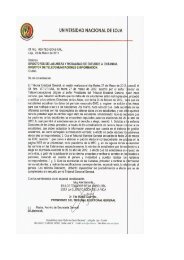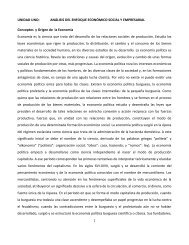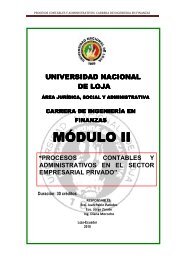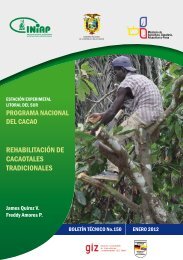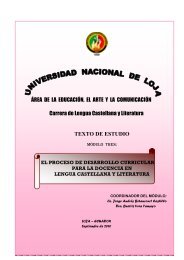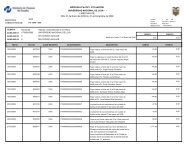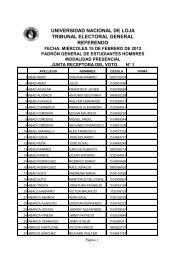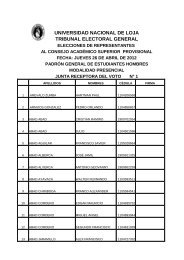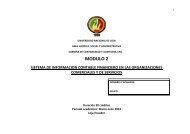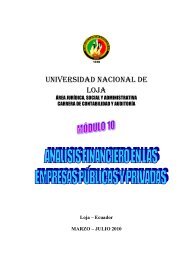module 5 planning of the english language teaching-learning process
module 5 planning of the english language teaching-learning process
module 5 planning of the english language teaching-learning process
Create successful ePaper yourself
Turn your PDF publications into a flip-book with our unique Google optimized e-Paper software.
UNIVERSIDAD NACIONAL DE LOJA<br />
Área de la Educación el Arte y la Comunicación<br />
English Language Career<br />
B. This is a story about a little boy who used to live in <strong>the</strong> city.<br />
C. Stories are very important for you. They will help you learn new<br />
grammar.<br />
Identifying <strong>the</strong> Functions <strong>of</strong> Learners’ Language<br />
How do we identify <strong>the</strong> functions <strong>of</strong> learners' <strong>language</strong>?<br />
The functions <strong>of</strong> learners' <strong>language</strong> are <strong>the</strong> purposes for which learners use<br />
<strong>language</strong> in <strong>the</strong> classroom. These purposes include taking part in tasks and.<br />
activities, asking questions <strong>of</strong> <strong>the</strong> teacher, interacting with each o<strong>the</strong>r. Examples<br />
<strong>of</strong> <strong>the</strong> functions <strong>of</strong> learners' <strong>language</strong> are asking for clarification from <strong>the</strong><br />
teacher or o<strong>the</strong>r learners, and checking information or understanding.<br />
Key concepts<br />
Can you think <strong>of</strong> some common functions <strong>of</strong> learners' <strong>language</strong>?<br />
Read through this description <strong>of</strong> a lesson. There are examples <strong>of</strong> learners'<br />
<strong>language</strong> functions for each stage.<br />
Learners'<br />
functions<br />
Greeting<br />
<strong>language</strong><br />
Asking for clarification<br />
Checking information<br />
and understanding<br />
Saying goodbye<br />
Teacher's and /earners' actions<br />
The teacher enters <strong>the</strong> classroom and <strong>the</strong> learners say 'Good<br />
morning'. The teacher hands out a reading text and gives<br />
learners instructions for <strong>the</strong> reading task.<br />
The learners check <strong>the</strong> instructions with <strong>the</strong> teacher by asking<br />
'Can you explain that again please? What do we have to do? ’<br />
The learners complete <strong>the</strong> reading task individually. The learners<br />
check <strong>the</strong>ir answers in pairs. They say, e.g. 'What answer do you<br />
have for number 4? I doesn’t understand <strong>the</strong> meaning <strong>of</strong> this<br />
word. Do you know what it means?' The teacher checks <strong>the</strong><br />
answers.<br />
The lesson ends. The learners say 'Goodbye' to each o<strong>the</strong>r and<br />
to <strong>the</strong> teacher.<br />
Key concepts and <strong>the</strong> <strong>language</strong> <strong>teaching</strong> classroom<br />
Learners need a range <strong>of</strong> classroom <strong>language</strong> so that <strong>the</strong>y can interact<br />
appropriately with each o<strong>the</strong>r and with <strong>the</strong> teacher. The <strong>language</strong> that learners<br />
need for interacting with each\ o<strong>the</strong>r may sometimes be quite formal, and at<br />
o<strong>the</strong>r times more relaxed, depending on who is in <strong>the</strong> group. The <strong>language</strong> <strong>the</strong>y<br />
need for interacting with <strong>the</strong> teacher is <strong>of</strong>ten neutral or more formal.<br />
Learners need to know special words and phrases for certain games and<br />
activities. For example, It's my turn I It's your turn I I’m first I after you I I’ve won,<br />
[Escribir texto] Página 93



